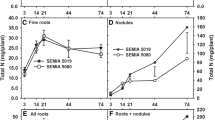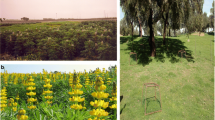Abstract
Accurate information on below-ground nitrogen (N) of legumes is necessary for quantifying legume effects on soil N pools and on the N economies of crops following legumes in rotation systems. We report a series of glasshouse pot experiments to determine below-ground N (BGN) of the four legumes, fababean (Vicia faba), chickpea (Cicer arietinum), mungbean (Vigna radiata) and pigeonpea (Cajanus cajan) using both 15N shoot-labelling and 15N-labelled soil isotope-dilution methods, a mass N balance approach and the physical recovery of nodulated roots. Data from the 15N shoot-labelling experiment were manipulated in different ways in an attempt to counter errors associated with uneven 15N enrichment of roots and nodules. Values for BGN as percent of total plant N based on the physical recovery of nodulated roots ranged from 4 to 15%. With 15N shoot-labelling, a total of 8.11 mg 15N was supplied to each pot (six plants) as 0.5% 15N urea using either leaf-flap (fababean, mungbean and pigeonpea), petiole (chickpea) or leaf-tip (wheat) feeding. Calculations based on measurement of 15N enrichments of harvested plant parts and root-zone soil suggested that BGN represented 39% of total plant N for fababean, 53% for chickpea, 20% for mungbean and 47% for pigeonpea. The value for wheat was 60%. Adjustment for uneven nodulation patterns on the roots and nodule 15N depletion, resulting in different 15N enrichments between nodulated and unnodulated roots, reduced the fababean value to 37% and chickpea to 42%. Values using the other methods were generally in the same range, viz. 15–57% (simple 15N balance), 11–52% (soil 15N dilution) and 30–52% (mass N balance). We conclude that physical recovery of roots was the most inaccurate method for estimating BGN. Average values for BGN as percent of total plant N using all isotopic and mass N balance methods were 30% for fababean, 48% for chickpea, 28% for mungbean, and 43% for pigeonpea.15N shoot-labelling may be the best method for quantifying BGN of field-grown plants. The methodology is simple, apparently accurate provided care is taken in obtaining representative nodulated root samples and, unlike the soil 15N dilution method, does not require pre-treatment of the soil with 15N enriched material.
Similar content being viewed by others
References
Bergersen F J, Brockwell J, Gault R R, Morthorpe L, Peoples M B and Turner G L 1989 Effects of available soil nitrogen and rates of inoculation on nitrogen fixation by irrigated soybeans and evaluation of δ15N methods for measurement. Aust. J. Agric. Res. 40, 763–780.
Bowren K E, Cooke D A and Downey R K 1969 Yield of dry matter and nitrogen from tops and roots of sweet clover, alfalfa and red clover at five stages of growth. Can. J. Plant Sci. 49, 61–68.
Chapman A L and Myers R J K 1987 Nitrogen contributions by grain legumes to rice grown in rotation on the Cununurra soils of the Ord irrigation area, Western Australia. Aust. J. Exp. Agric. 27, 155–163.
Crawford M C, Grace P R, Bellotti W D and Oades J m 1997 Root production of a barrel medic (Medicago truncatula) pasture, a barley grass (Hordeum leporinum) pasture, and a faba bean (Vicia faba) crop in southern Australia. Aust. J. Agric. Res. 48, 1139–1150.
Dalal R C, Strong W M, Doughton J A, Weston E J, McNamara g T and Cooper J E 1997 Sustaining productivity of a vertisol at Warra, Queensland, with fertilisers, no-tillage or legumes 4. Nitrogen fixation, water use and yield of chickpea. Aust. J. Exp. Agric. 37, 667–676.
Hansson A C and Steen E 1984 Methods of calculating root production and nitrogen uptake in an annual crop. Swedish J. Agric. Res. 14, 191–200.
Herridge D F 1982 Relative abundance of ureides and nitrate in plant tissues of soybean as a quantitative assay of nitrogen fixation. Plant Physiol. 70, 1–6.
Jensen E S 1996 Rhizodeposition of N by pea and barley and its effect on soil N dynamics. Soil Biol. Biochem. 28, 65–71.
Khan D F, Peoples m B and Herridge D F 2002 Quantifying belowground nitrogen of legumes. 1. Optimising procedures for 15N shoot-labelling. Plant Soil (submitted).
McNeill A M, Zhu C and Fillery I R P 1997 Use of in situ 15N-labelling to estimate the total below-ground nitrogen of pasture legumes in intact soil-plant systems. Aust. J. Agric. Res. 48, 295–304.
McNeill A M, Zhu C and Fillery I R P 1998 A new approach to quantifying the N benefit from pasture legumes to succeeding wheat. Aust. J. Agric. Res. 49, 427–436.
Palta J A, Fillery I R P, Mathews E L and Turner NC 1991 Leaf feeding of [15N] urea for labelling wheat with nitrogen. Aust. J. Plant Physiol. 18, 627–636.
Poth M, La Favre J S and Focht D D 1986 Quantification by direct 15N dilution of fixed N2incorporation in to soil by Cajanus cajan (pigeon pea). Soil Biol. Biochem. 18, 125–127.
Rochester I J, Peoples m B, Constable g A and Gault R R 1998 Faba beans and other legumes add nitrogen to irrigated cotton cropping systems. Aust. J. Exp. Agric. 38, 253–260.
Russell C A and Fillery I R P 1996a In situ labelling of lupin belowground biomass. Aust. J. Agric. Res. 47, 1035–1046.
Russell C A and Fillery I R P 1996b Estimates of lupin belowground biomass nitrogen, dry matter, and nitrogen turnover to wheat. Aust. J. Agric. Res. 47, 1047–1059.
Sheldrake A R and Narayanan A 1979 Growth, development and nutrient uptake in pigeon peas (Cajanus cajan). J. Agric. Sci., Camb. 92, 513–526.
Toomsan B, McDonagh J F, Limpinuntana V and Giller K E 1995 Nitrogen fixation by groundnut and soybean and residual nitrogen benefits to rice in farmers' fields in Northeast Thailand. Plant Soil 175, 45–56.
Unkovich M J and Pate J S 2000 An appraisal of recent field measurements of symbiotic N2 fixation by annual legumes. Field Crops Res. 65, 211–228.
Author information
Authors and Affiliations
Rights and permissions
About this article
Cite this article
Khan, D.F., Peoples, M.B., Chalk, P.M. et al. Quantifying below-ground nitrogen of legumes. 2. A comparison of 15N and non isotopic methods. Plant and Soil 239, 277–289 (2002). https://doi.org/10.1023/A:1015066323050
Issue Date:
DOI: https://doi.org/10.1023/A:1015066323050




